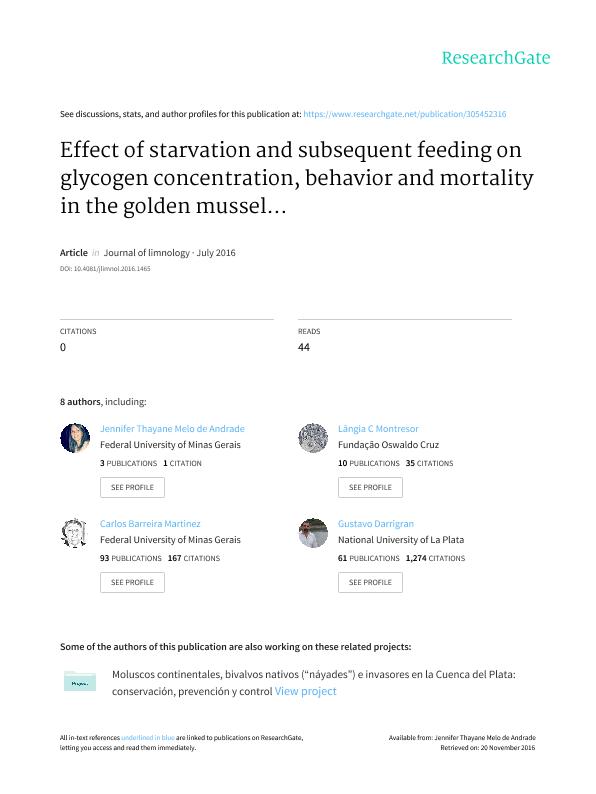Artículo
Effect of starvation and subsequent feeding on glycogen concentration, behavior and mortality in the golden mussel Limnoperna Fortunei (Dunker, 1857) (Bivalvia: Mytilidae)
Cordeiro, Nelmara I. S.; Andrade, Jennifer T. M.; Montresor, Lângia C.; Luz, Dalva M. R.; Martinez, Carlos B.; Darrigran, Gustavo Alberto ; Pinheiro, Jairo; Vidigal, Teofânia H. D. A.
; Pinheiro, Jairo; Vidigal, Teofânia H. D. A.
 ; Pinheiro, Jairo; Vidigal, Teofânia H. D. A.
; Pinheiro, Jairo; Vidigal, Teofânia H. D. A.
Fecha de publicación:
07/2016
Editorial:
Cnr Ist Italiano Idrobiologia
Revista:
Journal of Limnology
ISSN:
1723-8633
e-ISSN:
1129-5767
Idioma:
Inglés
Tipo de recurso:
Artículo publicado
Clasificación temática:
Resumen
The success of Limnoperna fortunei as an invasive species is related to its physiological plasticity that allows them to endure adverse environmental conditions. Starvation tolerance is considered to be an important trait associated with bivalve invasiveness. In natural ecosystems, food resources can vary during the year, exposing mussels to variable periods of starvation or limited food availability. Thus, mussels have developed physiological strategies to tolerate fluctuations in food availability. Glycogen concentration has been used in different monitoring studies as an indicator of the nutritional condition of bivalves. The aim of this study was to investigate the physiological responses of L. fortunei based on the glycogen concentrations of specimens under four treatments, comprising differentcombinations of feeding and starvation, during 125 days. The experiment was carried out in two phases. In the phase I, mussels were divided in two treatments: starvation (S) and feeding (F). After 100 days, tissue samples were collected to quantify glycogen concentrations and, each phase I group was divided in two subgroups: starvation (S) and feeding (F), resulting in four treatments. In the phase II, that lasted 25 days, starvation specimens (S) from phase I were allowed to feed (starvation-feeding treatment, or S-F), or continued to undergo starvation (starvation-starvation treatment, or S-S) and the feeding specimens (F) continued feeding (feeding-feeding group, or F-F), or were subjected to starvation (feeding-starvation treatment, or F-S). Behavior (valve-closing) and mortality were recorded in 24 h intervals. After the 25 days (phase II) all specimens were killed, and thei r soft tissue was removed to quantify glycogen concentrations. The glycogen concentration of the S-F treatment was lower than that of the F-S treatment, which was initially allowed to feed (phase I) and then subjected to starvation (phase II). Stability in the glycogen concentrations was observed when the phase II feeding conditions were maintained during the experiments, as observed in the S-S (continued starvation) and F-F (continued feeding) treatments. Based on our glycogen concentrations results, the golden mussel shows a higher tolerance to starvation (125 days) than has previously been published, which suggests that its tolerance strongly influences its invasive behavior.
Palabras clave:
Bioinvasion
,
Comparative Physiology
,
Glycogen
,
Golden Mussel
,
Starvation
Archivos asociados
Licencia
Identificadores
Colecciones
Articulos(CCT - LA PLATA)
Articulos de CTRO.CIENTIFICO TECNOL.CONICET - LA PLATA
Articulos de CTRO.CIENTIFICO TECNOL.CONICET - LA PLATA
Citación
Cordeiro, Nelmara I. S.; Andrade, Jennifer T. M.; Montresor, Lângia C.; Luz, Dalva M. R.; Martinez, Carlos B.; et al.; Effect of starvation and subsequent feeding on glycogen concentration, behavior and mortality in the golden mussel Limnoperna Fortunei (Dunker, 1857) (Bivalvia: Mytilidae); Cnr Ist Italiano Idrobiologia; Journal of Limnology; 75; 3; 7-2016; 618-625
Compartir
Altmétricas



